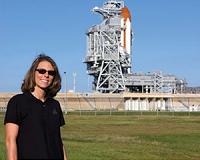 |
Schriever AFB CO (SPX) Apr 21, 2010 April marks the 40th Anniversary of the failed Apollo 13 mission and the near loss of its astronauts, James Lovell, John "Jack" Swigert, and Fred Haise. Apollo 13 was NASA's third moon shot, following the Apollo 11 lunar landing on July 20, 1969, which was repeated by Apollo 12 on Nov. 19, 1969. The mission, however, was plagued by challenges. Three days before the April 11, 1970 launch, crew member and command module pilot Thomas K. "Ken" Mattingly was removed from the mission. He had been exposed to German measles. Fellow astronaut, former Air Force officer, and Colorado native, John L. "Jack" Swigert, Jr., replaced Mattingly for the scheduled 10-day mission with the objective to land on the hilly Fra Mauro region of the lunar surface. Following an uneventful launch, the mission seemed to be on track with no serious incidents. That changed on the third day. Nearly fifty-six hours into the mission, while Swigert performed a stir of the oxygen tanks, a spark from a damaged electrical wire resulted in a failure in the cryogenic oxygen system and an explosion in the command service module. The explosion made the command module virtually unusable. Oxygen stored in the command module was lost within about three hours. So too was the crew's water, electrical power, and propulsion system. Swigert was the first to report to flight control with the now famous phrase, "Okay, Houston. Hey, we've had a problem here." Almost immediately the mission objective changed from a lunar landing to getting the three astronauts home safely. Coordinating with flight control and other experts at NASA, the astronauts were determined to make a life boat of the lunar module. Their challenge lay in the design of the lunar module. A craft designed to support two astronauts for two days would now be required to support three astronauts for as many as four days. Oxygen availability, carbon dioxide buildup, water availability, and numerous other challenges had to be overcome for the crew to survive in the narrow lunar module. And, the crew would need a way to reclaim the command module and power it up for re-entry and splash down. Engineers on the ground at the Houston and Kennedy Space Centers developed processes and procedures and tested solutions on trainer mock-ups. Working closely with NASA engineers, the crew found a solution to the very dangerous problem of ridding the lunar module of carbon dioxide by venting it to tanks in the command service module. NASA engineer, Charles Mars, developed a process to recharge the command service module's re-entry batteries from the lunar module's electrical system. At the recommendation of Kennedy Space Center engineers the crew turned off the radar heaters to save electricity. This presented new issues, as the temperature in the lunar module fell and remained as low as 38 degrees. North American Aerospace and Grumman engineers at KSC helped develop ways to transfer water from the portable life support systems into the lunar module's water coolant system. On April 17, 1970, Apollo 13 splashed down in the Pacific Ocean near Samoa. Four hours before splash down, the crew separated the command service module which had been severely damaged in the explosion. After days of testing, NASA engineers had developed and tested a way to return the command module to service for the splash down, and the Apollo 13 crew followed those procedures. One hour before splash down, the crew moved to the command module and using pressure, blasted the lunar module Aquarius, which had served as their life boat, away from the command module. The emergency had re-awakened interest in the U.S. Space Program and countries around the globe offered assistance. Jack Swigert resigned from NASA in 1977 to enter politics. In November 1982, Coloradoans elected him to the U.S. House of Representatives. Jack Swigert died Dec. 28, 1982, before he could be sworn in. Building 400 on Schriever AFB is named in honor of John L. "Jack" Swigert, Jr., whose life reflects the Air Force core values.
Share This Article With Planet Earth
Related Links NASA Space Tourism, Space Transport and Space Exploration News
 Will Love To Be Part Of ISRO Prog: NASA Astronaut Trainer
Will Love To Be Part Of ISRO Prog: NASA Astronaut TrainerBangalore, India (PTI) Apr 21, 2010 Michelle Ham, a trainer for astronauts at NASA, has expressed her willingness to extend her support to the ISRO's human space flight programme slated for 2015-16. "I would be delighted and honoured," Michelle told PTI when asked if she was ready to take up the assignment if offered by the Indian Space Research Organisation. "I would love to be part of the Indian space programme when ... read more |
|
| The content herein, unless otherwise known to be public domain, are Copyright 1995-2010 - SpaceDaily. AFP and UPI Wire Stories are copyright Agence France-Presse and United Press International. ESA Portal Reports are copyright European Space Agency. All NASA sourced material is public domain. Additional copyrights may apply in whole or part to other bona fide parties. Advertising does not imply endorsement,agreement or approval of any opinions, statements or information provided by SpaceDaily on any Web page published or hosted by SpaceDaily. Privacy Statement |